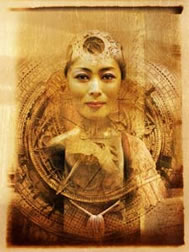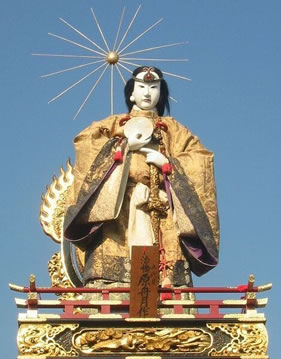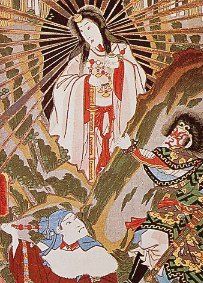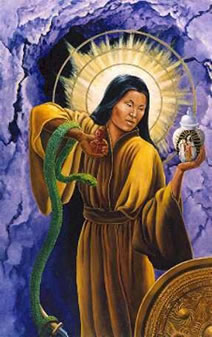Calling Amaterasu
The Great Eastern Sun Goddess of Peace
Shannyn Sollitt
At 8:15 on the morning of August 6th, 1945, the Enola Gay dropped the first uranium nuclear bomb over the city of Hiroshima, Japan. “History” (as written by the then ruling US patriarchs), tells us that this bomb, Little Boy, along with Fat Man, the plutonium bomb dropped over Nagasaki, brought a swift end to the Second World War and saved American lives.
Diligent research reveals an entirely different story. Hirohito, the Emperor of Japan, stepped out from behind the curtain and finally asserted his will over the war- mongering political leaders of Japan. Throughout the war he had remained in the role of Japan’s religious figurehead, not a political leader. Hirohito sent an envoy to deliver a document with a deep and heartfelt surrender to Truman, Churchill and Stalin at the Potsdam Conference outside Berlin. 1 They knew, and the Generals and Admirals on the ground also knew, that the Japanese were utterly defeated.
Meanwhile at Potsdam, July 16th, Truman was nervously awaiting news about the test of the plutonium atomic bomb detonated at dawn over the white sands of Alamogordo, New Mexico at what Oppenheimer named the Trinity Site. When Truman was handed a note—“It’s a boy!”—he knew he could refuse this surrender from Emperor Hirohito, easily win the war against Japan, and show the world the invincible power behind our military machine. The western scientists had given birth to a monstrosity that would not only decimate the Japanese, but also show Russia (vying for the spoils of war in the European amphitheater) and the rest of the world, that the US was the new superpower of the world.
Truman insisted that the Japanese fulfill a condition he knew would be nigh impossible to accept — the Emperor must step down and disavow his direct lineage to the deity Amaterasu, the Goddess of the Sun, the supreme figurehead of Japan’s core Shinto belief. Three weeks later, the bombs that rivaled the power of the sun and that birthed the nuclear age succeeded in ending the war. But in those three weeks, how many US warships were destroyed by kamikaze pilots? In history books we never learn how many American lives were lost during that frenzied period. Japan’s kamikaze pilots, basically suicide bombers, sacrificed their lives in a last ditch-effort to save their Emperor using bombers as bombs, since the entire country was completely out of fuel. Those A-bombs that the patriarchy to this day claims saved American lives were simply the first shots of the Cold War, setting off a global arms race that has expanded to eight countries pouring precious resources into developing and possessing what they believe to be their greatest protection, the only deterrent to nuclear war: nuclear bombs. 2
the Emperor must step down and disavow his direct lineage to the deity Amaterasu, the Goddess of the Sun, the supreme figurehead of Japan’s core Shinto belief. Three weeks later, the bombs that rivaled the power of the sun and that birthed the nuclear age succeeded in ending the war. But in those three weeks, how many US warships were destroyed by kamikaze pilots? In history books we never learn how many American lives were lost during that frenzied period. Japan’s kamikaze pilots, basically suicide bombers, sacrificed their lives in a last ditch-effort to save their Emperor using bombers as bombs, since the entire country was completely out of fuel. Those A-bombs that the patriarchy to this day claims saved American lives were simply the first shots of the Cold War, setting off a global arms race that has expanded to eight countries pouring precious resources into developing and possessing what they believe to be their greatest protection, the only deterrent to nuclear war: nuclear bombs. 2
I live just 35 miles from Los Alamos National Lab in Santa Fe, New Mexico. The realities of the nuclear bomb production complex in New Mexico are very present and disturbing. In 1998, I originated the Los Alamos Peace Project, whose stated intent is to transform the laboratories creating weapons of mass destruction into institutions that engage only in life- affirming research and development.
In 1999, just before the birth of the new millennium, I was invited to host a performance tour from California called First Light - Shedding the Skin of the Nuclear Age. The idea was to light the “First Light of the Post Nuclear Age” from the light of the Sun at the Trinity Site on July 16th, Trinity Day. This light would then be carried to other nuclear sites in the US, Europe, Japan and eventually to the top of Mt. Fuji—along with the skin of a boa constrictor, a host of performance artists and a survivor of the atomic bomb in Hiroshima. Every stop on the tour included performances, press conferences, ceremonies and meetings with survivors of the nuclear industrial complex.
Because of the clouds obscuring the sun on that Trinity Day, we ended up, instead of a fire-lighting ceremony, holding a water-healing ceremony at a petroglyph monument overlooking the Trinity Site where some of New Mexico’s indigenous people had lived. It felt very appropriate. The inhabitants of that place had fled from that site after witnessing the detonation of the bomb—never to return. The next day, somehow destiny proclaimed that I should be the one to light the “First Light of the Post Nuclear Age,” using a magnifying glass. Together with hibakusha Takashi Tannemori (an A-bomb survivor from Hiroshima), peace cranes folded by children, artifacts from Hiroshima and Nagasaki, and a video camera man, we made deep prayers for world peace while lighting the flame. 3
After the troupe departed from New Mexico, I re-joined them in Japan for the end of the tour. Along with fifty Japanese people, I made that final climb to the top of Mr. Fuji to shed the skin of the nuclear age. After spending a freezing night with a terrible storm slamming the doors of the rest hut at the very top, at sun up we were forced out in the midst of the storm by the head proprietor of all the rest huts on Fuji. This man was the meanest and most inconsiderate man I ever encountered in Japan. Oddly, he was guarding what the Japanese consider to be one of their most sacred sites. I felt sure he was the storm god incarnate. So there we were in the midst of an intense blizzard and cyclone winds. We all circled up, silently honoring each other and our mission—and held up our boa skins. The skins were miraculously sucked from our hands into the heavens. To add to the bizarre supernatural quality of the experience, as we all circled up in this blinding blizzard to release the skins, sunlight illuminated us.
 It was on this tour that I first learned Amaterasu’s story, which had been performed during the entire tour by a remarkable Asian American performance duo who call themselves Eth-Noh-Tech. They performed her story once again at sun-up in the hut at the top of Fuji where we spent the night. To discover her filled me with joy. Throughout human cosmologies, the male has been portrayed as the light-giving force and the female as the dark — yin and yang. It is hard for anyone to dispute that males of our species have brought a very dark, evil, destructive death force to the planet. In this story, a female is actually recognized as a deity of light! Amaterasu’s life story is an allegory that (curiously) pertains not only to the past century of war and the birth of the Nuclear Age, but also to this time in herstory that calls upon the brilliance of the feminine to bring forth the medicines of peace so needed to heal our world.
It was on this tour that I first learned Amaterasu’s story, which had been performed during the entire tour by a remarkable Asian American performance duo who call themselves Eth-Noh-Tech. They performed her story once again at sun-up in the hut at the top of Fuji where we spent the night. To discover her filled me with joy. Throughout human cosmologies, the male has been portrayed as the light-giving force and the female as the dark — yin and yang. It is hard for anyone to dispute that males of our species have brought a very dark, evil, destructive death force to the planet. In this story, a female is actually recognized as a deity of light! Amaterasu’s life story is an allegory that (curiously) pertains not only to the past century of war and the birth of the Nuclear Age, but also to this time in herstory that calls upon the brilliance of the feminine to bring forth the medicines of peace so needed to heal our world.
The story goes: Suza-no-wo, Amaterasu’s brother, the Storm God, had finally been banished from the Celestial Land of the Immortals to the Underworld for his endless misdeeds. Before leaving, he trekked to the palace of his sister the Sun Goddess to bid her a final farewell. Amaterasu was very mistrusting of the motives for his visit. Her brother, eternally jealous of her brilliance, had always done everything in his power to diminish and make trouble for her. But this time he came to say a final goodbye with an earnest offering of his good will. And to prove it, he gave her his precious sword. In return, Amaterasu gave him her treasured necklace, the Thread With Five Hundred Jewels. But after turning to take his leave, Suza-no-wo had a second thought. He told Amaterasu he might just take a quick detour, to go have his way with the goddesses weaving silks in her weavers’ hall. Disgusted, Amaterasu told him to be on his way. Complaining bitterly that females just didn't know how to have fun, Suza-no-wo declared, “What our world needs is more male deities!” Amaterasu disagreed: more female deities were needed. The argument heated up. Suza-no-wo swallowed her necklace and spit out male deities. Amaterasu retaliated by swallowing his sword and spitting out female deities. A terrible gender battle ensued. Finally Suza-no-wo seized Amaterasu’s beloved celestial horse, flayed it alive and brought it crashing down upon the weaving hall, destroying and/or terrorizing everything she treasured in her life, her livelihood, her weavers, her children.
 In fury and grief, with Suza-no-wo’s wild, raucous laugh echoing in her ears, and trembling with fear Amaterasu hid herself away in a celestial grotto to mourn, pushing a large stone to cover the door. The whole world, now cloaked in eternal night, was invaded by evil, the spirits of darkness and woe, hunger and cold, violence and death. As all the beings in all the realms grieved their loss, the goddesses and gods held council around a bonfire outside her cave to conspire to bring her out again. They placed a great Sakaki Tree close to the cave entrance with a mirror hanging on it. Finally, a crone, Uzume, showed up. As she unfolded a hilarious tale, lasciviously revealing her naked breasts and flashing her yoni, everyone roared with laughter. Amaterasu’s curiosity got the better of her. She moved the stone slightly to peek out and see what was causing all the fuss and caught a glimpse of her own reflection in the mirror hanging in the tree. Holy Goddess! For the first time she got it: She was the light of the world! All this time she had been viewing herself through her brother’s eyes. She had never before understood why she was the only one without a shadow. Astounded, she hesitatingly emerged from her refuge. Tajikahara-wo held his hand to draw her out. Another god Tutu-Tamu held up a straw mat behind her to prevent her from retreating. When Amaterasu-Oho-mi-Kami smiled, the world became completely bathed in sunlight.
In fury and grief, with Suza-no-wo’s wild, raucous laugh echoing in her ears, and trembling with fear Amaterasu hid herself away in a celestial grotto to mourn, pushing a large stone to cover the door. The whole world, now cloaked in eternal night, was invaded by evil, the spirits of darkness and woe, hunger and cold, violence and death. As all the beings in all the realms grieved their loss, the goddesses and gods held council around a bonfire outside her cave to conspire to bring her out again. They placed a great Sakaki Tree close to the cave entrance with a mirror hanging on it. Finally, a crone, Uzume, showed up. As she unfolded a hilarious tale, lasciviously revealing her naked breasts and flashing her yoni, everyone roared with laughter. Amaterasu’s curiosity got the better of her. She moved the stone slightly to peek out and see what was causing all the fuss and caught a glimpse of her own reflection in the mirror hanging in the tree. Holy Goddess! For the first time she got it: She was the light of the world! All this time she had been viewing herself through her brother’s eyes. She had never before understood why she was the only one without a shadow. Astounded, she hesitatingly emerged from her refuge. Tajikahara-wo held his hand to draw her out. Another god Tutu-Tamu held up a straw mat behind her to prevent her from retreating. When Amaterasu-Oho-mi-Kami smiled, the world became completely bathed in sunlight.
According to Asiatic Mythology 4, a beautiful book I inherited that had been translated from the French original, Amaterasu subsequently became the recognized Ruler of all the immortal realms and the world below. With the recognition of her own true identity and power came responsibility. After her awakening, she re-ordered the Celestial Realms before turning her attention to the Earthly Realms, which were in a terrible state of turmoil. After many failed attempts, she managed to finally send down her grandson Ninigi to become ruler. When he arrived, he brought with him emissaries who founded the Shinto religion to maintain the spiritual connection with the Goddess. He also brought with him the mirror that had been hung on the great Sakaki Tree, Suza-no-wo’s sword and Amaterasu’s jewel necklace that to this day are kept in a temple at Ise and are the insignias of the power of the Emperor of Japan. Interestingly, (another story – nothing to do with this event, but his journey in the Earth realm) Amaterasu’s brother Suza-no-wo was also transformed. No longer in competition with his sister, he became known in Japan as the God of Love.
I am an unabashed goddess worshipper. The Goddess Tara drew me to Tibetan Buddhist practice. Instead of a Buddhist, I call myself a Tara-ist. A meditative practice of Tibetan Tantric Buddhism is to concentrate in adoration on a deity and invite all the attributes of that deity into ones own soul body, thereby providing a physical form in which the deity can manifest in the Earthly realm. Because of my Tibetan Buddhist practice, I receive healing, comfort, protection from the Tibetan White Tara of Long Life, (also my given name when I took the Buddhist vows).
 Learning the story of Amaterasu awakened inside me a gentle, kind and loving goddess who embodies the light-giving power of the sun. How many of us goddess-worshipping, Earth-loving, peace-adoring believers in the powers of divinity in humanity are suffering in our caves, nursing our broken hearts as we witness the havoc, the devastation, the destruction of the very fabric of our world? How many of us recognize that combating the violent patriarchy on its own terms brings disaster? How many of us cling to a certain image of lack —a belief in our own deficiency—that inhibits us from really opening to and recognizing our true brilliance?
Learning the story of Amaterasu awakened inside me a gentle, kind and loving goddess who embodies the light-giving power of the sun. How many of us goddess-worshipping, Earth-loving, peace-adoring believers in the powers of divinity in humanity are suffering in our caves, nursing our broken hearts as we witness the havoc, the devastation, the destruction of the very fabric of our world? How many of us recognize that combating the violent patriarchy on its own terms brings disaster? How many of us cling to a certain image of lack —a belief in our own deficiency—that inhibits us from really opening to and recognizing our true brilliance?
How many of us can fathom that the feminine spirit and soul, the warp and the weft of life on this precious planet, is the light of the whole world? If we can fathom it, what are we doing about that wrathful singular god of the patriarchy who has driven us into our caves? Can he be transformed, like Suzano-wo, into the God of Love? And how about awakening to the wild lascivious crone in us— Uzume—who is not afraid to play the sacred fool and so draws us out of the darkness? Can we collectively hold up the mirror for each other? Can men, too, play a role by exhibiting due respect and drawing us out?
I've recently been introduced to America. She is the courageous Indigenous goddess dressed in Athena-like clothing who stands on the US Capitol Dome in Washington, DC. An Iroquois woman, America stands peacefully, waiting to be recognized. Her right hand rests on a sheathed sword, the other on a shield, the US Constitution. She stands on a globe inscribed with E Pluribus Unum, (Out of Many One). The US Constitution was derived directly from the Great Law of Peace of the Iroquois Nation. 5 The eagle in America’s headdress is the primary symbol atop the Tree of Peace, a key element of the Great Law of Peace. America, The Goddess of Freedom Triumphant, is yet another Goddess of Peace.
I just returned from participating in a run in South America, the Journey for Peace and Dignity. It was a relay run starting from both the tip of Alaska and the tip of Tierra Del Fuego in Argentina (they started at different times to meet at the same time). The runners, carrying prayer staffs from the indigenous nations, met in Panama, conjoining the staffs and medicines of the Eagle of the North and the Condor of the South for the empowerment of the Red Nations and to bring harmony and unity to the Americas and the world with song and prayer. Running down the mountain roads, past campesinos leading little donkeys loaded heavy with bananas, I could feel the energy of America’s eagle feather headdress on my head, a resistance of the wind, a fluttering. Eagle’s message: Living in harmony with the natural world is true freedom—peace. 6
My last name, Sollitt, means sunlight in the Norse languages. According to family history, in order to hide the French Celtic connection in Great Britain, the name was changed from Soleil (meaning sun in French) to Sol-litt. The Celtic clans, driven from France into England and Ireland by the Holy Roman Empire, were persecuted in Great Britain as well, so they had to hide their identity. The idea that my paternal genealogy originates from a sun clan gives me a sense of direct resonance with Amaterasu, whose wisdom and light empower my work to transform the grim potential of the nuclear disasters experienced in Japan into the realization of a world culture of peace.
Inside our stories are myriads of goddesses waiting to be recognized and adored, to live again. It is up to all of us to seek them out, gestate them, rebirth them, give them life and breath. They want nothing more than to bring their divine medicine to help heal our world.
Notes
- The surrender offered by Hirohito is documented on page 875 of Foreign Relations of the United States, Diplomatic Papers, The Conference of Berlin, (The Potsdam Conference), 1945, (In Two Volumes). The Library of Congress tried to block access of that volume of the Diplomatic Papers when I did research there in 2001.To read about the surrender (these are actually the words that he sent with the special envoy) without having to research it at the Library of Congress, go to my web site: http://www.losalamospeaceproject.us/peace-history.html. [back to article]
- Historian Gar Alperovitz was named "Distinguished Finalist" for the Lionel Gelber Prize for his work, The Decision to Use the Atomic Bomb (Knopf, 1995). In it, he elucidates the entire story behind the Potsdam Conference and the motives for dropping the bomb. [back to article]
- I have been holding ceremony to light a candle from the sun every year since 1999 on Trinity Day. I call it “The Light of the Solar Age.” I realize now that in the future I should call it “Amaterasu’s Light of World Peace.” [back to article]
- Asiatic Mythology, by J. Hackin, Henri Maspero and others, is not dated, except by the hand of my aunt Margaret Gentles, (my real aunt’s partner), June 1946. Margaret was the curator for Oriental Art at the Art Institute of Chicago. A google search uncovers that the book was printed in 1932, translated from the French version published by Musée Guimet of Paris, France’s National Museum of Asiatic Art. [back to article]
- The U.S. Constitution and the Great Law of Peace: A Comparison of Two Founding Documents, by Gregory Schaaf. Published by Center for Indigenous Arts & Cultures, a Native American-run non-profit empowering Indian traditional arts and crafts. The US Constitution left out many salient points, one being that the Elder Women’s Lodge chooses the leaders, that leader can never get angry, and, most importantly, the Elder Women’s Lodge has the last say before declaring war.
- I deeply resonate with America, dressed in European attire, an Iroquois Goddess carrying the message of the birth of Athena.
About the author
Shannyn Sollitt - My first name, Shannyn, is adapted from my grandmother’s maiden name, the same as the Shannon River in Ireland. The river was named after the Goddess Sinnan who came wildly rushing from the sea one day and dove right into the Well of Wisdom that was being carefully guarded by the old Druids. Her unbridled unruly act, to the dismay of the old stick-in-the-butt Druids, released all the wisdom from the well and it flowed out to the sea in what became the Shannon River. Sinnan freed all that wisdom for the benefit of the whole world and at the same time released the Salmon of Knowledge who, after swimming the seven seas, returned to the Well of Wisdom replenishing it with the great wisdom and knowledge of the whole world.
When I studied Sinnan’s stories in many varied Celtic accounts, I knew that she was inside of me. Her mission is mine. I call myself a Communications Artist. Besides occasionally being a bold and compassionate anarchist I founded and direct a non-profit corporation, NetWorks Productions, a communication arts production company, creating media, community events, educational programs and performances with a mission to disseminate wisdom and knowledge to inspire the care of the Earth and people. My favorite communication art is storytelling and community ceremony. I love sharing the myths sourced from the deepest truths of our human experience—especially stories of the goddesses. I rejoice that this recent turn in American politics, led by a President who openly worships his superfine and courageous mother, as well as his wife, represents a strong movement toward awakening the values of a truly egalitarian Society —“The Egalitarianarchy.” I humbly consider myself among the ranks of the Velvet Revolutionaries in the world, modeled after Vaclav Havel’s Velvet Revolution – the revolution of love.
Join our Trivia - Voices of Feminism group on Facebook

